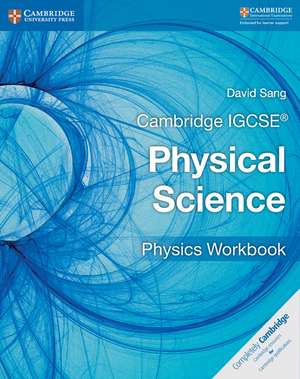Cambridge IGCSE® Physical Science Physics Workbook: Cambridge International IGCSE
Autor David Sangen Limba Engleză Paperback – 15 feb 2017
Din seria Cambridge International IGCSE
-
 Preț: 249.57 lei
Preț: 249.57 lei -
 Preț: 114.16 lei
Preț: 114.16 lei -
 Preț: 91.38 lei
Preț: 91.38 lei -
 Preț: 140.24 lei
Preț: 140.24 lei - 8%
 Preț: 546.82 lei
Preț: 546.82 lei -
 Preț: 211.56 lei
Preț: 211.56 lei -
 Preț: 301.93 lei
Preț: 301.93 lei -
 Preț: 232.85 lei
Preț: 232.85 lei -
 Preț: 94.21 lei
Preț: 94.21 lei -
 Preț: 414.24 lei
Preț: 414.24 lei -
 Preț: 250.67 lei
Preț: 250.67 lei -
 Preț: 128.73 lei
Preț: 128.73 lei -
 Preț: 347.04 lei
Preț: 347.04 lei -
 Preț: 241.30 lei
Preț: 241.30 lei -
 Preț: 240.49 lei
Preț: 240.49 lei -
 Preț: 129.64 lei
Preț: 129.64 lei -
 Preț: 111.95 lei
Preț: 111.95 lei -
 Preț: 145.49 lei
Preț: 145.49 lei -
 Preț: 125.99 lei
Preț: 125.99 lei -
 Preț: 218.19 lei
Preț: 218.19 lei -
 Preț: 127.04 lei
Preț: 127.04 lei -
 Preț: 328.53 lei
Preț: 328.53 lei -
 Preț: 324.73 lei
Preț: 324.73 lei -
 Preț: 96.14 lei
Preț: 96.14 lei -
 Preț: 192.41 lei
Preț: 192.41 lei -
 Preț: 298.70 lei
Preț: 298.70 lei -
 Preț: 93.60 lei
Preț: 93.60 lei -
 Preț: 80.01 lei
Preț: 80.01 lei -
 Preț: 161.04 lei
Preț: 161.04 lei -
 Preț: 101.58 lei
Preț: 101.58 lei -
 Preț: 244.90 lei
Preț: 244.90 lei -
 Preț: 167.03 lei
Preț: 167.03 lei - 9%
 Preț: 628.29 lei
Preț: 628.29 lei -
 Preț: 89.90 lei
Preț: 89.90 lei -
 Preț: 258.62 lei
Preț: 258.62 lei -
 Preț: 90.96 lei
Preț: 90.96 lei -
 Preț: 267.40 lei
Preț: 267.40 lei -
 Preț: 257.86 lei
Preț: 257.86 lei -
 Preț: 93.16 lei
Preț: 93.16 lei -
 Preț: 140.05 lei
Preț: 140.05 lei - 9%
 Preț: 847.69 lei
Preț: 847.69 lei -
 Preț: 289.21 lei
Preț: 289.21 lei -
 Preț: 256.24 lei
Preț: 256.24 lei -
 Preț: 182.62 lei
Preț: 182.62 lei -
 Preț: 130.29 lei
Preț: 130.29 lei -
 Preț: 414.66 lei
Preț: 414.66 lei -
 Preț: 116.52 lei
Preț: 116.52 lei -
 Preț: 283.53 lei
Preț: 283.53 lei -
 Preț: 129.86 lei
Preț: 129.86 lei
Preț: 116.97 lei
Nou
Puncte Express: 175
Preț estimativ în valută:
22.38€ • 23.37$ • 18.52£
22.38€ • 23.37$ • 18.52£
Carte disponibilă
Livrare economică 14-28 martie
Preluare comenzi: 021 569.72.76
Specificații
ISBN-13: 9781316633526
ISBN-10: 1316633527
Pagini: 178
Dimensiuni: 221 x 277 x 10 mm
Greutate: 0.49 kg
Editura: Cambridge University Press
Colecția Cambridge University Press
Seria Cambridge International IGCSE
Locul publicării:Cambridge, United Kingdom
ISBN-10: 1316633527
Pagini: 178
Dimensiuni: 221 x 277 x 10 mm
Greutate: 0.49 kg
Editura: Cambridge University Press
Colecția Cambridge University Press
Seria Cambridge International IGCSE
Locul publicării:Cambridge, United Kingdom
Cuprins
Introduction; How to use this book; P1. Making measurements; P1.1 The SI system of units; P1.2 Paper measurements; P1.3 Density data; P1.4 Testing your body clock; P2. Describing motion; P2.1 Measuring speed; P2.2 Speed calculations; P2.3 More speed calculations; P2.4 Distance–time graphs; P2.5 Acceleration; P2.6 Velocity–time graphs; P3. Forces and motion; P3.1 Identifying forces; P3.2 The effects of forces; P3.3 Combining forces; P3.4 Force, mass and acceleration; P3.5 Mass and weight; P3.6 Falling; P4. Turning effects of forces; P4.1 Turning effect of a force; P4.2 Calculating moments; P4.3 Stability and centre of mass; P4.4 Make a mobile; P5. Forces and matter; P5.1 Stretching a spring; P5.2 Stretching rubber; P5.3 Pressure; P6. Energy transformations and energy transfers; P6.1 Recognising forms of energy; P6.2 Energy efficiency; P6.3 Energy calculations; P7. Energy resources; P7.1 Renewables and non-renewables; P7.2 Wind energy; P7.3 Energy from the Sun; P8. Work and power; P8.1 Forces doing work, transferring energy; P8.2 Calculating work done; P8.3 Measuring work done; P8.4 Power; P9. The kinetic model of matter; P9.1 Changes of state; P9.2 The kinetic model of matter; P9.3 Understanding gases; P10. Thermal properties of matter; P10.1 Calibrating a thermometer; P10.2 Demonstrating thermal expansion; P10.3 Thermal expansion; P11. Thermal (heat) energy transfers; P11.1 Conductors of heat; P11.2 Convection currents; P11.3 Radiation; P11.4 Losing heat; P12. Sound; P12.1 Sound on the move; P12.2 Sound as a wave; P13. Light; P13.1 On reflection; P13.2 Refraction of light; P13.3 The changing speed of light; P13.4 A perfect mirror; P13.5 Image in a lens; P14. Properties of waves; P14.1 Describing waves; P14.2 The speed of waves; P14.3 Wave phenomena; P15. Spectra; P15.1 Electromagnetic waves; P15.2 Using electromagnetic radiation; P16. Magnetism; P16.1 Attraction and repulsion; P16.2 Make a magnet; P16.3 Magnetic fields; P17. Static electricity; P17.1 Attraction and repulsion; P17.2 Moving charges; P17.3 Static at home; P18. Electrical quantities; P18.1 Current in a circuit; P18.2 Current and charge; P18.3 Electrical resistance; P18.4 Electrical energy and power; P19. Electric circuits; P19.1 Circuit components and their symbols; P19.2 Resistor combinations; P19.3 More resistor combinations; P19.4 Electrical safety; P20. Electromagnetism; P20.1 Using electromagnetism; P20.2 Electricity generation; P20.3 Transformers; P21. The nuclear atom; P21.1 The structure of the atom; P21.1 Isotopes; P22. Radioactivity; P22.1 The nature of radiation; P22.2 Radioactive decay equations; P22.3 Radioactive decay; Answers.
Descriere
Cambridge IGCSE® Physical Science resources tailored to the 0652 syllabus for first examination in 2019, and all components of the series are endorsed by Cambridge International Examinations.

